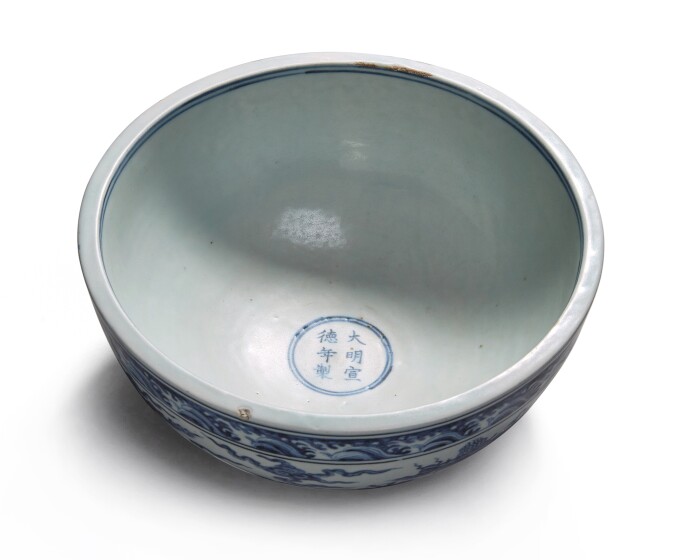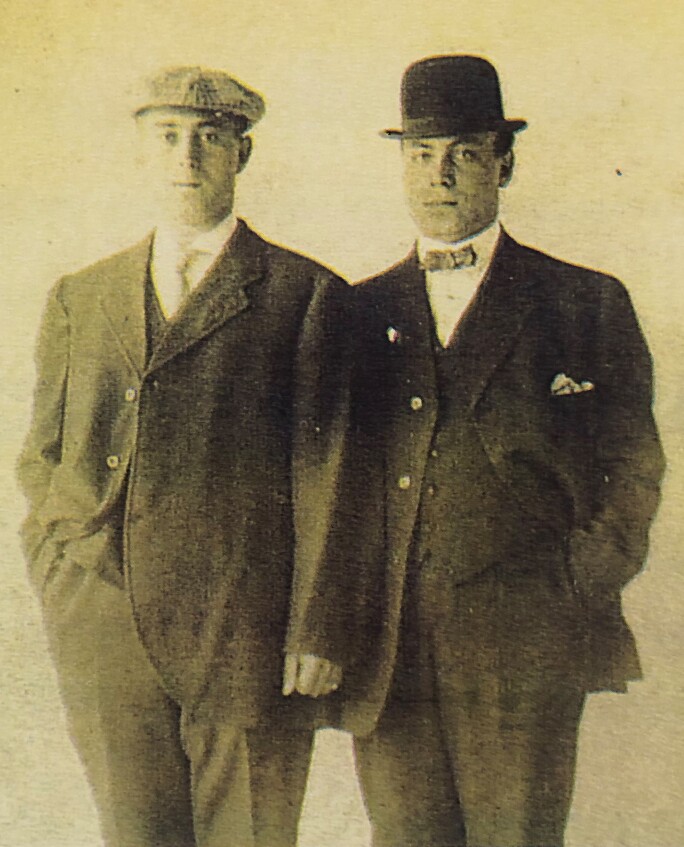AN ICONIC EMBLEM OF IMPERIAL POWER
A 'DRAGON' BOWL FOR THE XUANDE EMPEROR
Powerful yet elegant, bold yet refined, this present bowl exemplifies the celebrated aesthetics of blue and white porcelain produced during the Xuande period (1425-35). Following the Yongle Emperor’s (r. 1402-1424) initiation of unprecedented control of the kilns in Jingdezhen, the short but prosperous reign of the Xuande Emperor saw further refinement and innovation, elevating the level of blue and white porcelain production to new heights.
A Rare Piece of Chinese History: the ‘Dragon’ Dice Bowl from the Friedman Collection
-
 Sotheby's StoriesHow Jane Birkin's Original Hermès Birkin Bag Made History... Again | A Sotheby's Auction Story
Sotheby's StoriesHow Jane Birkin's Original Hermès Birkin Bag Made History... Again | A Sotheby's Auction Story -
 Handbags & FashionJane Birkin's Original Hermès Birkin Bag Shatters Auction Records at $10.1 Million | Sotheby's
Handbags & FashionJane Birkin's Original Hermès Birkin Bag Shatters Auction Records at $10.1 Million | Sotheby's -
 Geek WeekA 54-Pound Martian Meteorite Just Landed at Sotheby's — But How Did It Get Here?
Geek WeekA 54-Pound Martian Meteorite Just Landed at Sotheby's — But How Did It Get Here?
A devoted patron of the arts and an artist himself, the Xuande Emperor took great interest in the production of porcelain at the imperial kilns of Jiangxi. Under the close scrutiny of court officials and eunuchs who were sent to Jingdezhen to supervise production, the kilns were able to vastly increase their capacity while improving the standard of workmanship. Indeed, the staggering number of shards unearthed from the Xuande stratum at the Imperial kiln site in Zhushan, Jingdezhen, and the large collection of extant Xuande wares in the Qing Court Collection, now housed in Beijing and Taipei, suggest a dramatic increase in production and stricter level of quality control.

Representative of the many remarkable technical and artistic advances made during this period, the bowl is masterfully drawn – the powerful dragons emerge from the waves in an extraordinary range of rich blue tones derived from the sumali cobalt. Imported from the Middle East with steady supply during the Yongle and Xuande period, the cobalt produced a deep blue pigment, allowing for the famous ‘heaping and piling’ effect, celebrated and extensively imitated on later blue and white porcelains. A further revision of the pigment formula in the Xuande reign enabled a greater precision of the brush work and a more consistent application of the cobalt, evident in the finer details on the bowl – the scales, claws and waves are executed with masterful precision, cleverly juxtaposed with the dynamic poses and expressions of the two robust mythical beasts. The bowl’s translucent, lustrous glaze and finely potted body also reflect the other ongoing advances in porcelain production during this time. This included the refinement of the glaze and kaolin clay, as well as the establishment of a repertoire of pre-designed forms and patterns, all working in union to create a sense of harmony and elegance that epitomize Xuande blue and white porcelains.

On account of the bowl’s solid potting and some unusual wear found on the interior of a few bowls of this type, these wares have traditionally been referred to as ‘dice’ bowls; assuming that the dense walls were made to endure the inevitable wear and tear of flying dice. However, in The Complete Collection of Treasures of the Palace Museum: Blue and White Porcelain with Underglazed Red (I), Shanghai, 2000, p. 132, the author discusses this particular form, bo, and relates it to the devout Buddhist practice of the Xuande Emperor and his court, suggesting that it may be associated with Buddhist alms bowls. It has also been speculated that these bowls were used as brush washers, as fruit bowls or for the popular game of cricket fights.
Compare a few closely related examples of Xuande mark and period ‘dice’ bowls in notable museum collections; one housed in the Palace Museum, Beijing, illustrated in ibid., pl. 124; another in the National Palace Museum, Taipei, included in the Special Exhibition of Selected Hsuan-te Imperial Porcelains of the Ming Dynasty, National Palace Museum,Taipei, 1998, cat. no. 37. See also one in the Victoria and Albert Museum, London, illustrated in Oriental Ceramics. The World's Great Collections, vol. 6, Tokyo, 1982, pl. 148, and lastly, one in the Freer Gallery of Art, Washington D.C., published in ibid., vol. 10, pl. 104.
A few closely related examples have also appeared in auction. See one, previously in the Wu Lai-Hsi Collection, sold in our London rooms, 26th May 1937, lot 52 and then again in the same rooms, 8th May 1951, lot 69, from the collection of C. M. Woodbridge; one from the collection of Major Lindsay F. Hay, sold in our London rooms, 16th June 1939, lot 84, and again from the collection of Lionel Edwards, 8th February 1945, lot 84 and for a third time, listed as from the estate of Major Lindsay F. Hay, 25th June 1946, lot 60. A bowl of this form, included in the exhibition of Ming Blue and White, Museum of Far Eastern Antiquities, Stockholm, 1964, cat. no. 31 and on loan to the museum between 1964 and 1974, was sold in our London rooms, 6th April 1976, lot 116. Compare another sold in our London rooms, 26th June 1973, lot 236, now in the Matsuoka Museum of Art, Tokyo and illustrated in Tōru Nakano, The Panoramic Views of Chinese Patterns, Tokyo, 1985, pl. 13.; one sold in our London rooms, 13th December 1977, lot 472, and then again in our Hong Kong rooms, 10th April 2006, lot 1659; one sold in our London rooms, 11th May 1965, lot 27 and later again at Christie's New York, 9th November 1981, lot 118 and another exhibited in Los Angeles County Museum, Los Angeles, from 1977 to 1983, sold in these rooms, 7th December 1983, lot 292. See also one sold at Christie’s Hong Kong, 20th March 1990, lot 519; another sold in our Hong Kong rooms, 29th October 1991, lot 30; one sold in these rooms, 19th March 1997, lot 230; and another sold at Christie’s London, 18th June 2002, lot 187.

This present bowl comes from the collection of Leon (d. 1961) and Max (d. 1942) Friedman, aviation pioneers who later established an automobile empire in China in the early 20th century. The two brothers emigrated from Romania to the United States in their early teens and soon found themselves in the business of promoting and organizing aviation shows. Initially, they started by working with the Wright brothers, Wilbur (1867-1912) and Orville (1871–1948), along the east coast, but soon expanded their company, Motordrome company, to the rest of the country. The shows were met with great success. Huge crowds gathered on the weekends to see pilots put on daring and riveting performances. At the center of these shows was Tom Duck Gunn (d. 1922), the first Chinese pilot who later reported back to China to instruct the Chinese Republic army, marking the beginning of the Chinese air force.
Looking to the East, the brothers brought these shows to Japan and China and noticed the huge opportunity of growth in China during their visits. In 1919, the brothers again left everything behind and moved to Shanghai, this time with their eyes fixed on the booming automobile industry in China. They quickly established China Motors Fed., Inc. USA, and became Chrysler’s largest export dealer in the world, setting up public showrooms all over the country, including in Shanghai, Hangzhou, Beijing, and supplying automobiles to the government and army. After more than 20 years, in 1940, the brothers returned to the United States due to the increasingly turbulent political crisis in China. Max Friedman passed away shortly thereafter in 1942, and Leon in 1961, both leaving behind a fascinating legacy and a lifetime of pioneering and adventure.
宣世華儀:青花雲龍紋缽
本品紋飾優雅精緻,刻畫雙龍矯健雄壯,乃屬宣德青花之臻例珍品。永樂年間,朝廷對景德鎮窰務開始嚴格管理,宣德帝承接前朝製瓷成就,創新技術,精益求精,帝祚雖短,卻將青花瓷藝術水平推至新的高度。
明宣宗擅藝好雅,極力推動文化發展,對江西景德鎮御窰製瓷事務倍加關注。在朝廷派遣的文官及宦官的監控下,景德鎮窰燒造數量大幅增長,工藝水平亦得到提升。景德鎮珠山官窰宣德地層出土瓷片數量驚人,清宮舊藏宣德瓷器更是珍品無數(現存於北京及台北),由此不難推斷宣德年間製瓷數量激增、品控嚴格。

本品充分展現了當朝的技術與美學成就,刻畫雙龍游躍於波濤之間,鈷藍色澤層次細密,採用進口蘇麻離青料。蘇麻離青自中東傳入,至永宣時期貨源穩定,其發色濃艷,獨有的鐵鏽斑頗具特色,為後世所製青花效仿。宣德年間,鈷藍料成份再經改動,使紋飾燒製更為精準,青花發色亦更趨均匀,賞鑒本品紋飾對於鱗片、龍爪、波紋的刻畫細緻入微,與雙龍的矯健雄姿及威猛神情形成鮮明對比。本缽釉料透亮,形態秀雅,從中可見此時期瓷器發展長足:除上乘釉料及高嶺土之外,此時期還創立了諸多器型及紋飾的標準,這一系列因素共同成就了宣德青花和諧優雅的典範。

本缽胎體厚重,内壁磨損頗不尋常,曾有觀點認為本缽乃為擲骰而製。然《故宮博物院藏文物珍品全集:青花釉裏紅(上)》,上海,2000年,頁132則論述,宣德帝及朝廷上下篤信佛教,此器或與僧缽相關聯。亦有推測此器為筆洗、果盤或為鬥蟋蟀所用。
比較著名博物館收藏作例,宣德年器並款:一件藏於北京故宮博物院,出處同上,圖版124;另一例藏於台北國立故宮博物院,收錄於《明代宣德官窰菁華特展圖錄》,國立故宮博物院,台北,1998年,編號37。另比一例,倫敦維多利亞與阿爾伯特博物館珍藏,圖載《Oriental Ceramics. The World's Great Collections》,卷6,東京,1982年,圖版148。尚有一例,為華盛頓弗利爾美術館收藏,前述出處,卷10,圖版104。
過往數年可見多例曾經亮相拍場。一例出自吳賚熙舊藏,售於倫敦蘇富比1937 年 5 月 26 日,編號 52,C.M. Woodbridge亦曾收藏該例,售於倫敦蘇富比1951年 5 月 8 日,編號 69;另一例來自Lindsay F. Hay少校收藏,售於倫敦蘇富比1939 年 6 月 16 日,編號 84,後入利昂內爾•愛德華收藏,於1945 年 2 月 8 日易手,編號 84,後於1946 年 6 月 25 日再度易手,編號60,署為Lindsay F. Hay少校遺產收藏。再比一例,器型相近,展於《Ming Blue and White》,斯德哥爾摩東方博物館,1964 年,編號31,1964 至1974 年間借展予該館,後於1976 年 4 月 6 日售於倫敦蘇富比,編號 116。亦比一例,售於倫敦蘇富比1973 年 6 月 26 日,編號 236,現藏於東京松岡美術館,載於中野徹,《中国の文様》,東京,1985年,圖版13;尚有一例,售於倫敦蘇富比1977 年 12 月 13日,編號 472,後易手於香港蘇富比2006 年 4 月 10日,編號 1659;另一例售於倫敦蘇富比1965 年 5 月11 日,編號 27,後易手於紐約佳士得1981 年 11 月 9日,編號 118 。洛杉磯郡藝術博物館1977 至 1983 年間亦展出一例,售於紐約蘇富比1983 年 12 月7日,編號 292。再比四例,分別售於:香港佳士得1990 年3 月 20 日,編號 519;香港蘇富比1991 年 10 月 29日,編號 30;紐約蘇富比 1997 年 3 月 19 日,編號230;以及倫敦佳士得2002 年 6 月 18 日,編號 187。

本品出自Leon(1961年逝)及 Max(1942年逝)Friedman兄弟收藏,二人乃航空業界先驅,20 世紀初曾在中國建立汽車產業帝國。兄弟二人在十多歲時從羅馬尼亞移民美國,旋即開始推廣和籌辦飛行演出。他們創立Motordrome公司,最開始在東海岸與威尔伯(1867-1912年)和奥维尔(1871-1948年)萊特兄弟合作,公司發展迅猛,業務很快擴展到了美國其他地區。演出事業極爲成功,每個週末都能吸引大批觀眾
前來觀賞飛行員大膽而精彩的表演。演出的焦點人物包括首位華人飛行員譚德根(Tom Duck Gunn,1922年逝),譚氏後來回到中國指導中華民國飛機隊,見證中國空軍發展之始。
Friedman兄弟放眼東方,將表演帶到日本及中國,期間洞察到中國市場之巨大發展機遇。1919年,兄弟二人再次拋下一切,移居上海,投身蓬勃發展的中國汽
車工業,迅速成立China Motors Fed Inc. USA,並成為克萊斯勒汽車在全球最大的出口經銷商,在上海、杭州及北京等中國各地設立汽車展銷廳,並為政府和軍隊供貨。二十餘載後中國時局動蕩,兄弟二人於1940年回到美國。此後不久Max Friedman先生於1942 年去世,Leon Friedman先生亦於1961作古,留下二人頗具冒險精神、先鋒開拓的傳奇人生故事,令人折服。